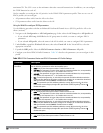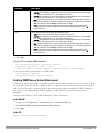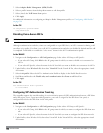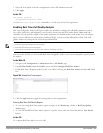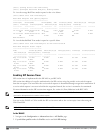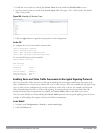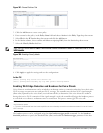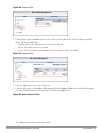
705 | VoiceandVideo DellPowerConnectW-SeriesArubaOS6.2 | User Guide
3. Select Adaptive Radio Management (ARM) Profile.
4. Select a profile instance from the drop-down menu to edit that profile.
5. Select (check) the VoIP Aware Scan option.
6. Click Apply.
For additional information on configuring an Adaptive Radio Management profile, see "Configuring ARM Profiles"
on page 348.
In the CLI
rf arm-profile <profile-name>
voip-aware-scan
Disabling Voice-Aware 802.1x
NOTE: The Voice-Aware 802.1x support is deprecated for ArubaOS 5.0 and later releases.
Although reauthentication and rekey timers are configurable on a per-SSID basis, an 802.1x transaction during a call
can affect voice quality. If a client is on a call, 802.1x reauthentication and rekey are disabled by default until the call
is completed. You disable or re-enable the “voice aware” feature in the 802.1x authentication profile.
In the WebUI
1. Navigate to the Configuration > AP Configuration page. Select either AP Group or AP Specific.
l If you select AP Group, click Edit for the AP group name for which you want to disable voice awareness for
802.1x.
l If you select AP Specific, select the name of the AP for which you want to disable voice awareness for 802.1x.
2. Under Profiles, select Wireless LAN, then select Virtual AP. In the Virtual AP list, select the appropriate virtual
AP instance.
3. Select AAA profile. Select the 802.1x Authentication Profile to display in the Profile Details section.
4. Scroll down and deselect the Disable rekey and reauthentication for clients on call check box.
5. Click Apply.
In the CLI
aaa authentication dot1x <profile>
no voice-aware
Configuring SIP Authentication Tracking
The controller supports the stateful tracking of session initiation protocol (SIP) authentication between a SIP client
and a SIP registry server. Upon successful registration, a user role is assigned to the SIP client. You specify a
configured user role for the SIP client in the AAA profile.
In the WebUI
1. Navigate to the Configuration > AP Configuration page. Select either AP Group or AP Specific.
l If you select AP Group, click Edit for the AP group name for which you want to configure the SIP client user
role.
l If you select AP Specific, select the name of the AP for which you want to configure the SIP client user role.
2. Under Profiles, select Wireless LAN, then select Virtual AP. In the Virtual AP list, select the appropriate virtual
AP instance.







